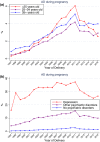Trend of antidepressants before, during, and after pregnancy across two decades-A population-based study
- PMID: 31613060
- PMCID: PMC6851806
- DOI: 10.1002/brb3.1441
Trend of antidepressants before, during, and after pregnancy across two decades-A population-based study
Abstract
Introduction: Factors that influence antidepressant (AD) prescription and use during pregnancy are multiple including, in particular, the balance between the potential risk of untreated depression and the potential risk of AD treatment. Surveillance of temporal trends of AD use might identify areas requiring further research. We studied the use of ADs before, during, and after pregnancy using national data across two decades in Denmark.
Methods: We included 1,232,233 pregnancies leading to live birth in Denmark between 1 January 1997 and 31 December 2016. Information on redemption of AD prescriptions was obtained from the Danish National Prescription Register.
Results: We identified 29,504 (2.4%) pregnancies having at least one AD prescription (96,232 AD prescriptions) during pregnancy. The majority redeemed more than one prescription (69.7%) often for a single kind of AD (83.5%), and in 94% of the AD-exposed pregnancies, the estimated duration of treatment was 1 month or longer. Prescription of ADs during pregnancy increased steadily from 0.4% in 1997 to 4.6% in 2011, but decreased thereafter to 3.1% in 2016. The proportion of pregnancies with ADs in 2011 was 6.05-fold higher than that in 1997. The temporal trends in AD prescription in the years before and after pregnancy were similar to the trend during pregnancy. The decreasing use of ADs during pregnancy after 2011 was mainly driven by a decrease in the use of selective serotonin reuptake inhibitors (SSRIs), especially citalopram, the main type of SSRIs used in Denmark.
Conclusion: Prescription of ADs during pregnancy in Denmark increased steadily from 1997 to 2011 but decreased sharply thereafter. More research is needed to show whether the same trend exists in other populations, like women of reproductive age, men of reproductive age, and old people, and other countries. We also need to find explanation for the decreasing trend in recent years and potential risk for untreated depression.
Keywords: antidepressants; depression; epidemiology; pregnancy.
© 2019 The Authors. Brain and Behavior published by Wiley Periodicals, Inc.
Conflict of interest statement
Dr. Christensen reported receiving honoraria from serving on the scientific advisory boards of, and giving lectures for, UCB Nordic and Eisai AB, as well as receiving travel funding from UCB Nordic. No other disclosures were reported.
Figures





References
-
- Abbing‐Karahagopian, V. , Huerta, C. , Souverein, P. C. , de Abajo, F. , Leufkens, H. G. M. , Slattery, J. , … De Bruin, M. L. (2014). Antidepressant prescribing in five European countries: Application of common definitions to assess the prevalence, clinical observations, and methodological implications. European Journal of Clinical Pharmacology, 70(7), 849–857. 10.1007/s00228-014-1676-z - DOI - PubMed
-
- Bauer, M. , Monz, B. U. , Montejo, A. L. , Quail, D. , Dantchev, N. , Demyttenaere, K. , … Tylee, A. (2008). Prescribing patterns of antidepressants in Europe: Results from the Factors Influencing Depression Endpoints Research (FINDER) study. European Psychiatry, 23(1), 66–73. 10.1016/j.eurpsy.2007.11.001 - DOI - PubMed
-
- Benard‐Laribiere, A. , Pambrun, E. , Sutter‐Dallay, A. L. , Gautier, S. , Hurault‐Delarue, C. , Damase‐Michel, C. , … Pariente, A. (2018). Patterns of antidepressant use during pregnancy: A nationwide population‐based cohort study. British Journal of Clinical Pharmacology, 84(8), 1764–1775. 10.1111/bcp.13608 - DOI - PMC - PubMed
Publication types
MeSH terms
Substances
Grants and funding
LinkOut - more resources
Full Text Sources
Medical

